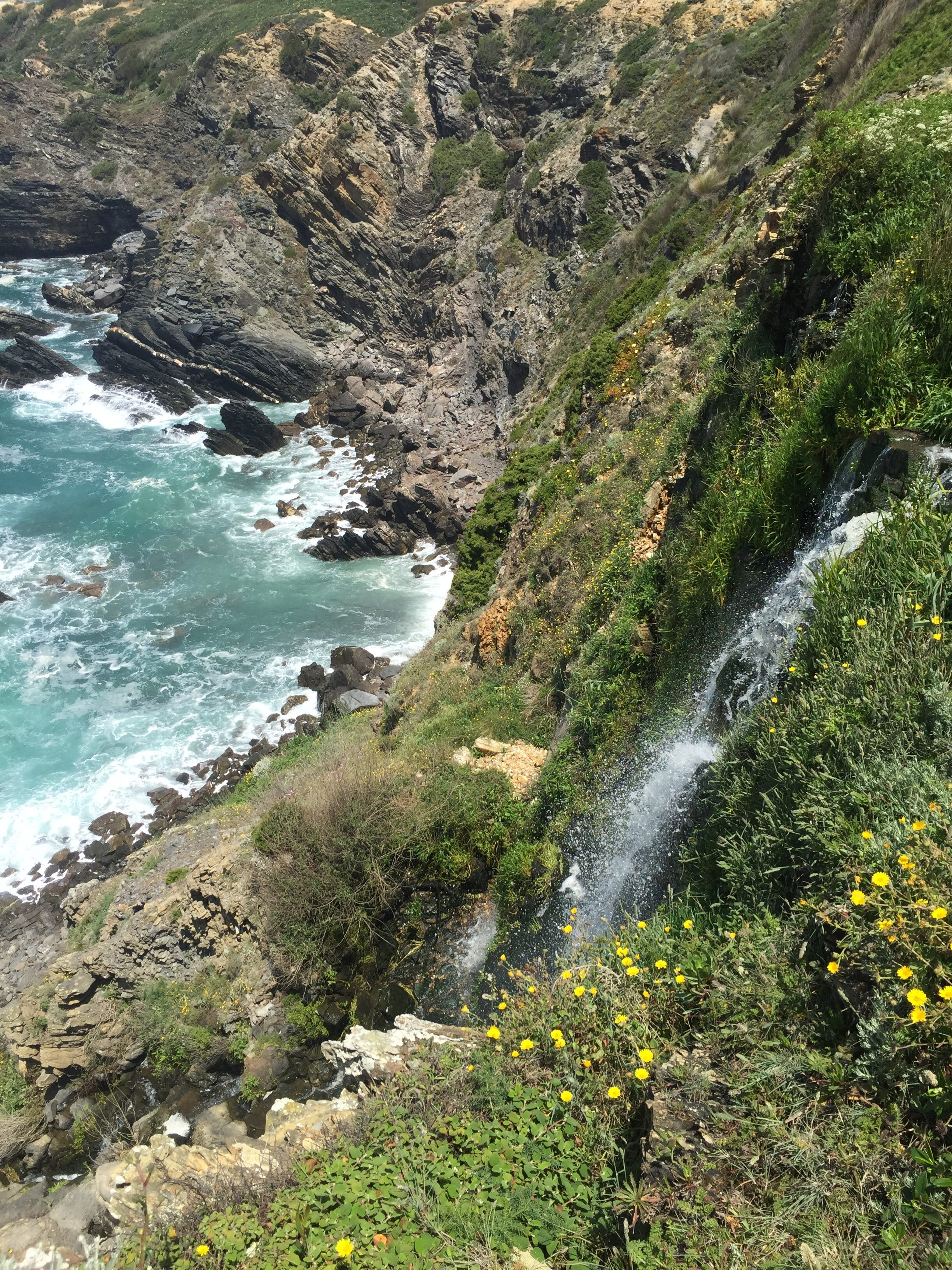During my travels, I am always fascinated by the diversity of residential architecture and its architectural background. What formulated needs were the planning based on, what are site-related compromises, what conversions have been made, what were the economic limits and where do aesthetics and design beat function?
Particularly here in Portugal, in this small country, different settlement sizes alternate. In addition to the major cities such as Lisbon, Porto and Coimbra, there are a large number of medium-sized and small towns such as Braga, Setúbal, Evora, Faro and many others. These are often surrounded by agricultural sprawl. Further afield, there are isolated areas of houses, farms and small hamlets.

In all locations, buildings vary in size and condition. Ruins, buildings in need of renovation, well-preserved houses, modern renovations to new builds. In rural areas, there is also always a mixture of VAN use and tiny houses in clay construction or as construction trailers.
But who are the Residents?
In 2022, 798,480 foreign citizens were registered in Portugal. That is 7.6 percent of the population of around 10 million people. This makes Portugal one of the countries in the world with the lowest proportion of immigrants in the total resident population. The most strongly represented nationalities in Portugal are Brazilians (29.3%), British (6%), Cape Verdeans (4.9%), Italians (4.4%), Indians (4.3%) and Romanians (4.1%). A total of 20,500 German citizens are registered as residents in Portugal. In terms of the total number of inhabitants, the municipalities of the Algarve are again those in which the foreign population accounts for more than a third of the inhabitants in 2022.
Source:
Newsletter – om (acm.gov.pt)
Algarve News from December 18 to 24, 2023 – Algarve for explorers (algarve-entdecker.com)

see also: Portugal – Wikipedia
1 | Traditional mountain villages
In the mountains of the Sierra Estrella, the Sierra do Geres and other mountain regions in the interior of the country, there are small mountain villages, often houses built in schist. There are the former animal stables in the basement. Warmed by this, the people lived above them. These were populations with a high degree of self-sufficiency. The journey to other settlements was arduous and long.
Today, some of these settlements are protected and used for culture and art.
Slate villages – Centro de Portugal

2 | Ruins used by Shepherds, Olive- and Orange Growers
If you travel through the countryside on foot or by bike and leave the roads – carved into the landscape by large machines, it quickly becomes clear how difficult it was even to get from one settlement to another. It therefore made sense to build houses close to the herd or the cultivation area. These ruins – often crumbling down to their foundations – are now abandoned and offer dropouts the opportunity to rebuild.

3 | Decay in the Cities
Uninhabited houses can be found in the streets of all cities. Their condition has often been unkempt for years. And so the strongly alternating external influences quickly eat into the simple substance. In the mountains, the range in winter from around zero degrees to 40 degrees in summer, from extremely dry to warm and humid, is a major structural challenge. Moisture in the form of moss and mold finds its way through the often cramped building stock. Plaster crumbles, roofs become perforated, wood rots.
In rural areas, vacancies are caused by the exodus of the young population. In urban areas, my guess, is a combination of three reasons. Firstly, the owner will lack the economic strength to maintain the building. The price trend in Portugal is comparatively high in “good” locations. Again and again I hear of communities of heirs which cannot agree to sell or maintain the house, or which hope for better prices in the future and therefore leave the house empty. As a third factor, I think the demand for modern living with light, living space and comfort is often no longer given in these small buildings. This would be a great opportunity for project developers, urban planners and architects to develop good concepts here. There are examples already existing.

4 | New buildings
In the suburbs of the cities, Portugal is also experiencing new construction. In addition to multi-storey buildings, there are also terraced housing estates. Unfortunately, Portugal will probably not be able to skip this development phase of single-family housing estates. From my experience, these concepts are currently being reconsidered in German city councils. Here, the desire of the middle class is creating a potential for the ruins of the future. Multi-storey buildings often appear careless and massive. Urban satellite towns are emerging. Where are the urban planners here who take quality of life in the neighbourhood and climate-friendly urban development into account?


5 | Magnificent Buildings
And of course there are the luxurious buildings, often inspired by Bauhaus, as individual houses or as residential and commercial buildings. Looking at these buildings in terms of their socio-ecological sustainability would be an asset in its own right.


6 | Refurbishment
This is where my heart beats the highest. Again and again, it is possible to revitalizing small refuges. Minimally intervening in the design, adding suitable rooms and materials and setting great colour accents.
The potential for this is huge and would be a win-win situation for everyone involved in the construction industry.

7 | Tourism Residential
And then there are the new buildings that are being constructed in tourist locations as vacation and second homes. I’m not talking about hotel complexes here, but about streets or entire neighbourhoods, that are only used during the season. Logically, the importance of sustainability takes a back seat to costs here. A quality is built that causes the appearance to fade after just a few years and becomes a deterrent. There are enough examples. What a pity.

8 | Re-Rual-Colonization
I often visit people who are looking for a combination of living close to nature, combined with self-sufficiency and personal development. There are the classic dropouts who travel around in a motorhome and at some point, following an impulse, acquire a plot of land – often cheaply in the hinterland. Structural progress is individual and very different. There are also dropouts as couples or families. The feeling of freedom and the possibility of agricultural use (keyword permaculture) then play an even greater role. Many of these projects now also offer their services on Airbnb or Park4Night.
These models are subject to a relatively high level of stress, as the economic opportunities are very limited and a high degree of individual commitment is required. The change from the “old” life to the “new” dream requires personal development. Many of these projects come to an end after some time.


9 | Community Projects
Based on the aforementioned re-rual-colonization projects, people are also repeatedly coming together to form groups or communities. They also want to live close to nature, free and healthy. Sometimes it remains with these goals, sometimes spiritual and intentional elements are anchored. Attempts are often made to create an external income situation through inner and physical health offers (e.g. yoga). This also includes educational programs and retreats.

Samples are

Tamera – Center for Peace Research and Education
permaculture and sustainable living (azula.bio)
10 | Cooperative Urban Communities
Housing cooperatives are a new form of housing and living model in Portugal. There are classic examples of this in Europe dating back over 100 years. Vienna, for example, is a stronghold of cooperative housing, as are Switzerland and parts of Germany. As far as I know, there are currently two specific projects in Portugal. Both are close to the city in the Lisbon area. Both use co-housing solutions to enable communal living and at the same time provide a place of retreat for families and individuals. Both projects strive for a model of good communication with each other to resolve conflicts and strengthen the supportive neighbourhood. Like my projects in Germany, both work with sociocracy and non-violent communication.

From my perspective, this type of project offers considerable potential to enable affordable housing combined with the social aspect of community. Isolation is avoided, refurbishment of existing buildings is made possible and socio-ecological sustainability comes into focus.

Bringing these models in scale, that could be a game changer.
Colmeia62 – Project in Mafra
brejosfaria – Project in Almeda
www.wohnenpluswangen.de – Project in Wangen – Germany
www.oekoseedorf.net – Project close to lake constance – Germany
11 | (Intermediate) Conclusion
Portugal is a fascinating country. The landscape and nature are diverse and impressive. The people are open and welcoming. Portugal is growing and has the opportunity to emerge as one of the winners of the current crisis situation. I am happy to be here and to be able to follow this development and perhaps play a small part in shaping it. Follow on #futurecasa
Roland Ehry | Dec. 2023






